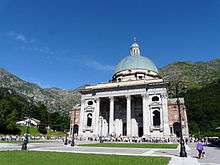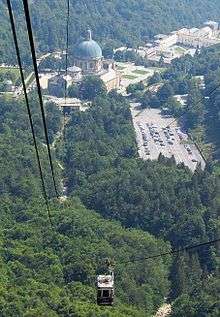Sanctuary of Oropa
| Sanctuary of Oropa | |
|---|---|
| Santuario della beata Vergine di Oropa[1] | |
|
View of the Ancient Basilica | |
 Sanctuary of Oropa | |
| 45°37′42″N 7°58′44″E / 45.628333°N 7.978889°ECoordinates: 45°37′42″N 7°58′44″E / 45.628333°N 7.978889°E | |
| Location | Biella |
| Country | Italy |
| Denomination | Catholic |
| Website |
www |
| History | |
| Authorising papal bull | 9th century |
| Dedication | Black Virgin of Oropa |
| Architecture | |
| Architectural type | Mainly baroque |
| Completed | 1960 |
| Administration | |
| Diocese | Diocese of Biella |
The Sanctuary of Oropa (Italian: santuario di Oropa), is a group of Roman Catholic buildings and structures in the municipality of Biella, Italy. It is located at a height of 1,159 metres in a small valley of the Alpi Biellesi.[2]
History

According to legend, a black wooden statue of the Virgin Mary carved by Saint Luke was found in Jerusalem by Saint Eusebius of Vercelli and carried to Oropa in the 4th century AD[3] and placed into a small niche in a big boulder. Around that niche housing the statue in the Middle Ages was built first a church, which during the early 17th century was replaced with what is known today as the Ancient Basilica. In the following two centuries several other buildings were added to the complex, including the royal apartments of the House of Savoy, a big library and the Royal Gate, a masterpiece designed by the architect Filippo Juvarra in the 18th century.[3]
The last building added to the sanctuary was the Upper Basilica, a monumental church built between 1885 and 1960 due the large number of pilgrims visiting Oropa.[4] Its dome is 80 metres high and the church can hold 3000 people.[5]
In 1617, the construction of the Sacro Monte di Oropa (literally Sacred Mount of Oropa) was built not far from the sanctuary. It is a devotional path now composed of twelve chapels (plus another seven nearby) containing groups of statues representing scenes from the story of the Virgin Mary's life.
Near the Sacro Monte in the XIX century was built a new graveyard, where the noble families of the Biellese territory built their family tombs. Some graves have free masons symbols, such as Quintino Sella's one.
Devotion and popular beliefs
The statue of the black Madonna has always been venerated and to the Virgin of Oropa are attributed miracles and protections. The town of Biella made a vow during the XVII century plague and it wasn't infected. Following this grace, the town does a pilgrimage every year to the sanctuary in order to thank the Virgin Mary.
People during the centuries made ex-voto (for grace) pictures to thank the Virgin Mary. All of these pictures are still preserved in the sanctuary in the 'ex voto gallery'. The oldest picture dates back to 1522 and was made by painter Bernardino Lanino.
The popular belief says that the wooden statue has some peculiar characteristics:
- despite the age of the statue it has no woodworm;[6]
- the foot, despite the ancient tradition of touching it for good luck, is not worn out;[7]
- dust does not settle on the faces of the Virgin and of the Baby.[8]
Pilgrimages
Around 800,000 pilgrims and one-hundred pilgrimages visit the sanctuary each year.[3]
The evocative and ancient pilgrimage from Fontainemore to Oropa takes place every five years.
Nature conservation

The mountain area surrounding the sanctuary is included in a regional park of 1,518.28 ha (code: EUAP0882) named Riserva Naturale Speciale del Sacro Monte di Oropa.[9]
Sports
Cicling
The Sanctuary has been five times the end of a stage of the Giro d'Italia.
| Year | Stage | Date | Track | km | Winner | Leader general classification |
|---|---|---|---|---|---|---|
| 1963 | 11ª | 29 May | Asti > Santuario di Oropa | 130 | ||
| 1993 | 20ª | 11 June | Torino > Santuario di Oropa | 162 | ||
| 1999 | 15ª | 30 May | Racconigi > Santuario di Oropa | 160 | ||
| 2007 | 13ª | 25 May | Biella > Santuario di Oropa (cron. individuale) | 12,6 | ||
| 2014 | 14ª | 24 May | Agliè > Oropa | 184 |
See also
- Sacro Monte di Oropa
- Black Virgin of Oropa
- Giardino Botanico di Oropa
- CoEur - In the heart of European paths
- Path of Saint Charles
- Giro d'Italia
References
- ↑ Dizionario di erudizione storico-ecclesiastica da S. Pietro sino ai nostri giorni, specialmente intorno ai principali santi, beati ..., Gaetano Moroni, Tipografia Emiliana, 1840; books.google.it (accessed in February 2014)
- ↑ CTR (Carta Tecnica Regionale) 1:10.000, Regione Piemonte, Settore Cartografico and Settore Sistema Informativo Territoriale, 2007 raster version
- 1 2 3 The sanctuary of Oropa, province of Biella tourist office; web page on www.atl.biella.it (accessed in February 2014)
- ↑ History of the sanctuary, official web-site www.santuariodioropa.it (accessed in February 2014)
- ↑ Santuario diOropa (BI), on www.camperontheroad.it (accessed in February 2014)
- ↑ Trompetto, Massimo (1993). Storia del Santuario di Oropa. Biella. pp. 20–25.
- ↑ "Santuario di Oropa (IV secolo) - Patrimonio dell'Umanità (UNESCO)". reginamundi.info. Retrieved 11 June 2015.
- ↑ Roberto Allegri. "Il mistero della "Madonna bruna"". tonyassant.com. Retrieved 11 June 2015.
- ↑ Riserva Naturale Speciale del Sacro Monte di Oropa, description on www.parks.it (accessed in February 2014)
Other projects
![]() Media related to Sacro Monte (Oropa) at Wikimedia Commons
Media related to Sacro Monte (Oropa) at Wikimedia Commons
